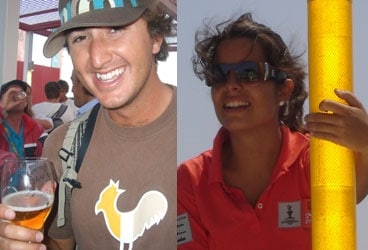
AC07_0620_Sanz
Like most of the world, strikes are a part of life in Europe. But one earlier this spring in Valencia was quite out of the ordinary. The group attempting to make itself heard was the legion of unpaid volunteers working for America’s Cup Management. The reason for the strike: They wanted to be allowed to report to work more than 30 minutes early. Imagine that, unpaid and unhappy because they were unable to work more than required.The volunteers on which America’s Cup Management relies so heavily come mostly from Spain and are more curious adventurers rather than hardcore sailing fans. Neus Sanz Sansaloni, a volunteer from Valencia, says that before this all started she knew more about the Cup than most Spanish, but that wasn’t much. “I knew that Alinghi had won,” she says. “The Kiwis, I knew they were around there; but I didn’t know what the competition was about.” But despite this limited knowledge of the sport, there’s been plenty of interest in getting involved. “It’s amazing that you can go to a city that doesn’t know anything about the America’s Cup and have that kind of participation,” says Danny Pavel, an American volunteering at the Cup during a trip through Europe. Both Sanz Sansaloni and Pavel say the attraction starts with the magnetism of the Cup experience. Coincidentally, they both even used the same phrase, “you get sucked in,” to describe the allure. “You come in to see how it works, and then you get sucked in,” says Sanz Sanasloni. “You can’t leave, but in a good way. It’s a way of life.” Sanz Sansaloni loved the volunteer way of life so much that she has been with the Cup for three years and turned down a paying job with Desafio Español. She juggles college courses and night and weekend jobs just so she can keep working as a Cup volunteer. Of course, there are a few perks. The race course volunteers enjoy the best view of the Cup races while they drop marks and record rounding times-they also do a lot of waiting around-and they are also treated to team appearances and countless social functions with more food and drink than they could possibly consume. Sanz Sansaloni, Pavel, and most other volunteers are here to see the sailing, and for the experience. For each volunteer that experience is unique: Pavel is learning a new language and culture. A friend came just for the social opportunities. Sanz Sansloni has a hard time explaining specifically why her time volunteering for America’s Cup Management has been so captivating. “It’s like when you are in love and someone asks you why,” she says. “Yes, you can say he’s cute, he’s nice, but you’re in love and you can’t really explain that.”When asked if she would travel out of Spain to go to the next Cup, Sanz Sansaloni pinpointed the unique culture of the America’s Cup. “The Cup is not really Spanish here. I’m from Valencia,” she says. “I live here, but at the moment it’s like I’m in another world at the port. It has absorbed me in such a way it’s like another country or city, it’s great.” In other words, of course she would travel to another Cup.One option is New Zealand. A a lot of insiders are worried about the return to such a small country so far away. Pavel thinks they should have more faith in such an enduring institution. “People say that New Zealand would kill the Cup, but I don’t think anything could kill the Cup,” he says. “I’m sure it’s gone through a lots harder stuff in the last 156 years. The people that love it are going to make it happen.”He should know. No one loves this event more than the people who are working at it simply for the sheer enjoyment of being part of such a spectacle.









